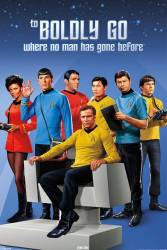Requiem for Methuselah - S3-E19
Visible crew/equipment: The monofilament line holding M-4 aloft is visible in the lab when the floating robot delivers the processed ryetalyn to McCoy. (00:17:20)
Requiem for Methuselah - S3-E19
Other mistake: As the miniaturized Enterprise appears on the table, the support for the model appears as well.
Requiem for Methuselah - S3-E19
Revealing mistake: When Spock examines the unknown Brahms waltz, we get a close-up of the music. Unfortunately, the hand-written score bears no resemblance whatsoever to the piece Spock has just played, though he expressly identifies it as such. (00:19:10)
Requiem for Methuselah - S3-E19
Continuity mistake: When looking at the view screen from the helm, there is a man sitting at the Conn position, but in the wide angle, there's a woman there.
Requiem for Methuselah - S3-E19
Other mistake: If the ship had not been in visual communication, there's no way Kirk could have seen the Bridge or the crew in suspension.
Requiem for Methuselah - S3-E19
Revealing mistake: As Kirk pulls the shroud away from the Rayna duplicate, look closely at the part of her head just below her left ear. The bald cap she wore to conceal her hair and give her an unfinished look.
Requiem for Methuselah - S3-E19
Factual error: Spock plays a piece on a harpsichord that he says is by Brahms, but Brahms was a late romantic composer and the piece is a simple baroque dance piece. Also by the time of Brahms the harpsichord was already obsolete, a composition like this wouldn't be sitting on a harpsichord.
Suggested correction: The first sentence is logical; if Spock is able to recognize the style as Brahms, then it should not possess the style and structure of Baroque music. The second sentence is not necessarily true because some romantic composers did write for the harpsichord. For instance, the late romantic composer Richard Strauss composed, "Divertimento for Chamber Orchestra after Keyboard Pieces by Couperin", which is scored with a harpsichord part.





